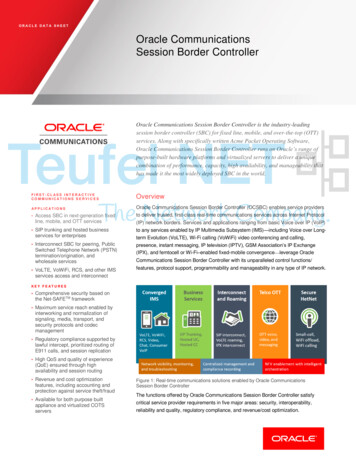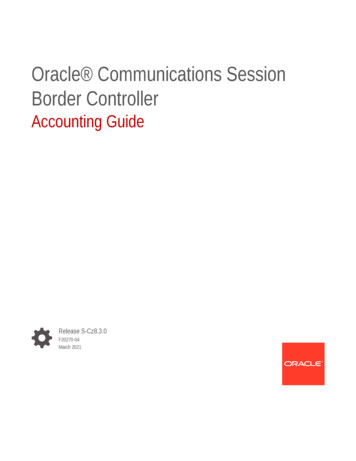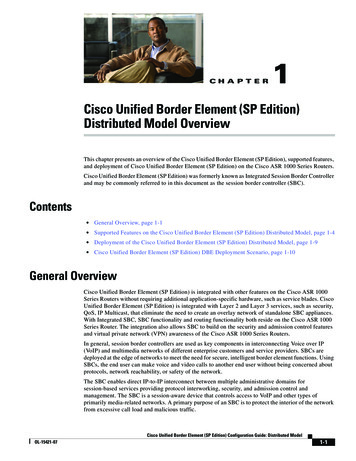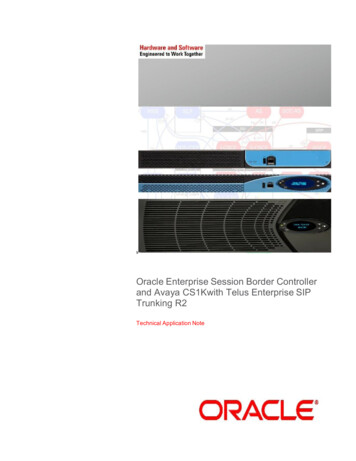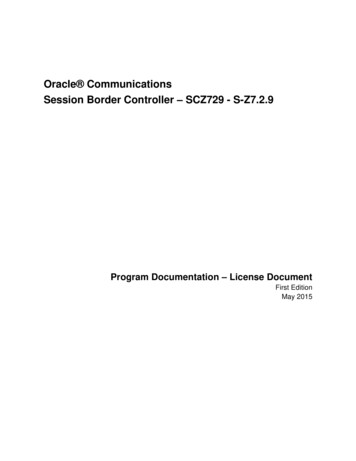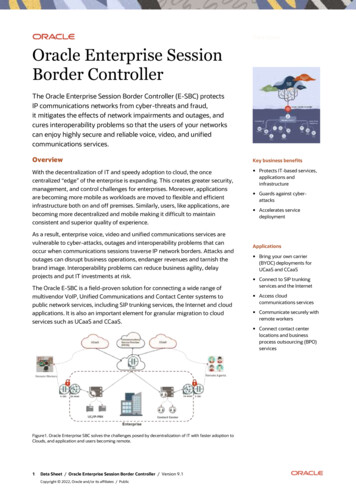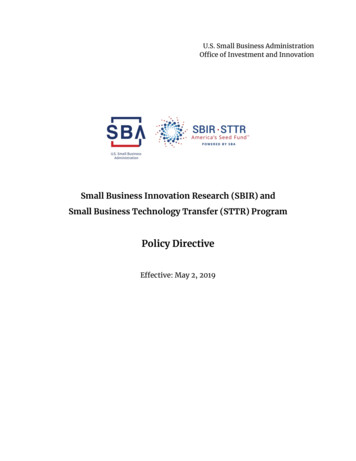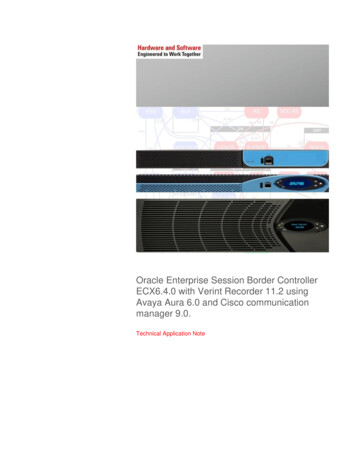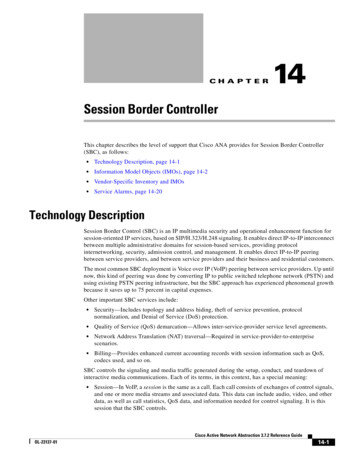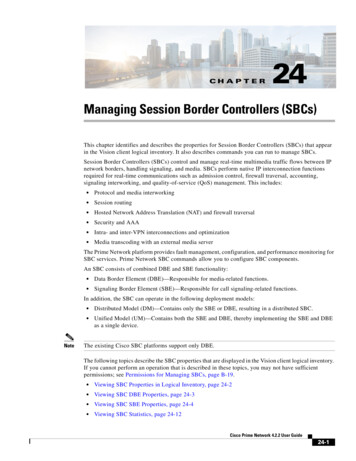
Transcription
CH A P T E R24Managing Session Border Controllers (SBCs)This chapter identifies and describes the properties for Session Border Controllers (SBCs) that appearin the Vision client logical inventory. It also describes commands you can run to manage SBCs.Session Border Controllers (SBCs) control and manage real-time multimedia traffic flows between IPnetwork borders, handling signaling, and media. SBCs perform native IP interconnection functionsrequired for real-time communications such as admission control, firewall traversal, accounting,signaling interworking, and quality-of-service (QoS) management. This includes: Protocol and media interworking Session routing Hosted Network Address Translation (NAT) and firewall traversal Security and AAA Intra- and inter-VPN interconnections and optimization Media transcoding with an external media serverThe Prime Network platform provides fault management, configuration, and performance monitoring forSBC services. Prime Network SBC commands allow you to configure SBC components.An SBC consists of combined DBE and SBE functionality: Data Border Element (DBE)—Responsible for media-related functions. Signaling Border Element (SBE)—Responsible for call signaling-related functions.In addition, the SBC can operate in the following deployment models:Note Distributed Model (DM)—Contains only the SBE or DBE, resulting in a distributed SBC. Unified Model (UM)—Contains both the SBE and DBE, thereby implementing the SBE and DBEas a single device.The existing Cisco SBC platforms support only DBE.The following topics describe the SBC properties that are displayed in the Vision client logical inventory.If you cannot perform an operation that is described in these topics, you may not have sufficientpermissions; see Permissions for Managing SBCs, page B-19. Viewing SBC Properties in Logical Inventory, page 24-2 Viewing SBC DBE Properties, page 24-3 Viewing SBC SBE Properties, page 24-4 Viewing SBC Statistics, page 24-12Cisco Prime Network 4.2.2 User Guide24-1
Chapter 24Managing Session Border Controllers (SBCs)Viewing SBC Properties in Logical Inventory Configuring SBC Components, page 24-13Viewing SBC Properties in Logical InventoryTo view SBC properties in the Vision client logical inventory, right-click the element configured forSBC, then choose Inventory Logical Inventory Session Border Controller.The SBC properties are displayed as shown in Figure 24-1.Figure 24-1SBC Properties in Logical InventoryTable 24-1 describes the general SBC properties displayed in logical inventory.Table 24-1SBC PropertiesFieldDescriptionProcessProcess name, such as Session Border Controller.Process StatusStatus of the process, such as Running.Application VersionSBC version number.ModeMode in which the SBC is operating:SBC Service NameCisco Prime Network 4.2.2 User Guide24-2 Unified Distributed DBEName of the service.
Chapter 24Managing Session Border Controllers (SBCs)Viewing SBC DBE PropertiesViewing SBC DBE PropertiesThe DBE controls media packet access to the network, provides differentiated services and QoS fordifferent media streams, and prevents service theft.To view SBC DBE properties, choose Logical Inventory Session Border Controller DBE.Table 24-2 describes the DBE properties that appear in logical inventory.Table 24-2SBC DBE PropertiesFieldDescriptionProcessProcess name, such as DBE.Process StatusStatus of the process, such as Running.NameName assigned to the DBE.TypeType of DBE, either DBE or virtual DBE (vDBE).DBE Location IdUnique identifier configured on each vDBE within a UM DBE.Viewing Media Address PropertiesA DBE uses a pool of sequential IPv4 media addresses as local media addresses.To view SBC media address properties, choose Logical Inventory Session BorderController DBE Media Address.Table 24-3 describes the SBC media address properties that are displayed in logical inventory.Table 24-3Media Address PropertiesFieldDescriptionAddress RangeIP addresses defined for the pool.Port Range LowerLower end of the port range for the interface. If no range is specified, all possibleVoice over IP (VoIP) port numbers are valid.Port Range UpperUpper end of the port range for the interface.VRF NameVRF that the interface is assigned to.Service ClassClass of service (CoS) for each port range, such as fax, signaling, voice, or any.Viewing VDBE H.248 PropertiesTo view VDBE H.248 properties, choose Logical Inventory Session BorderController DBE VDBE.Table 24-4 describes the VDBE H.248 properties that are displayed in logical inventory.Cisco Prime Network 4.2.2 User Guide24-3
Chapter 24Managing Session Border Controllers (SBCs)Viewing SBC SBE PropertiesTable 24-4VDBE H.248 PropertiesBranchDescriptionH248 ControllerH.248 controller used by the DBE.The Media Gateway Configuration (MGC) table displays the followinginformation:H248 Interface Index—The number of the H.248 controller. The profile is used tointeroperate with the SBE. Remote IP—The remote IP address for the H.248 controller. Remote Port—The remote port for the H.248 controller. Transport—The transport for communications with the remote device.The SBC H248 Control Interface table displays the following information: IP Address:– In DM mode, the local IP address of the DBE used to connect to theSBE.– In UM mode, the local IP address used to connect to the media gateway. Port—The port for the H.248 controller interface. Transport—The transport the H.248 controller interface uses. Association—The relationship between the SBE and the media gateway.Viewing SBC SBE PropertiesThe SBE controls the access of VoIP signaling messages to the network core and manipulates thecontents of these messages. It does this by acting as a SIP B2BUA or H.323 gateway.To view SBC SBE properties, choose Logical Inventory Session Border Controller SBE.Table 24-5 describes the information displayed in logical inventory for an SBE.Table 24-5SBC SBE PropertiesFieldDescriptionProcessName of the process, such as SBE.Process StatusStatus of the process, such as Running or Idle.NameName assigned to this SBE.Call Redirect LimitMaximum number of times a call is redirected before the call is declared failed.The range is 0 to 100 with a default of 2.On Hold TimeoutAmount of time, in milliseconds, that the SBE waits after receiving a mediatimeout notification from the DBE for an on-hold call before tearing down thecall.Cisco Prime Network 4.2.2 User Guide24-4
Chapter 24Managing Session Border Controllers (SBCs)Viewing SBC SBE PropertiesViewing AAA PropertiesFor devices that support local and remote billing, the SBC can send billing records to a AAA server usingthe RADIUS protocol.To view AAA properties, choose Logical Inventory Session Border Controller SBE AAA.Table 24-6 describes the AAA properties that appear in logical inventory for the SBC SBE.Table 24-6AAA PropertiesBranchDescriptionAAA InterfaceThe SBE AAA Interface table displays the following information:AccountingAuthenticationBilling AAA Address—The local AAA interface address. Network ID—A unique identifier for the SBE.The Accounting Radius Client table displays the following information: Name—The name of the accounting client. Client Type—The type of client, either Accounting or Authentication.The Authentication Radius Client table displays the following information: Name—The name of the authentication client. Client Type—The type of client, either Accounting or Authentication.The SBE Billing table displays the following information related to billing: LDR Check Time—The time of day (local time) to run the long durationrecord check. Local Billing Address—The local IP address for SBE billing. This IPaddress can be different from the local AAA IP address and is the IP addresswritten in the bill records. Admin Status—The configuration status, available with the running-configcommand. Operational Status—The running status, available from the CLI. This entryindicates whether or not the billing interface is up. The status is derived fromthe interworking of the SBC and the AAA server.Viewing H.248 PropertiesThe H.248 interface is used for signaling between an SBE and a DBE in distributed mode and betweenan SBE and a transcoding media gateway. The SBE or SBC acts as an H.248 MGC, and the transcodingdevice acts as an H.248 media gateway. The connection between the MGC and the media gateway is anH.248 link.To view H.248 properties, choose Logical Inventory Session Border Controller H248.Table 24-7 describes the H.248 properties that appear in logical inventory for the SBC SBE.Cisco Prime Network 4.2.2 User Guide24-5
Chapter 24Managing Session Border Controllers (SBCs)Viewing SBC SBE PropertiesTable 24-7H.248 PropertiesBranchDescriptionH248 InterfaceThe SBC H248 Control Interface table displays the following information: IP Address:– In DM mode, the IP address used to connect the DBE and the MGC.– In UM mode, the IP address used to connect the SBC and the mediagateway.Media Gateway Port—The port for the H.248 controller interface. Transport—The transport the H.248 controller interface uses. Association—The relationship between the SBE and the media gateway.The Media Gateway table displays the following information: IP Address—The IP address of the media gateway. Codec List—A comma-separated list of the codecs supported.Viewing Policy PropertiesAn SBC policy is a set of rules that define how the SBC treats different kinds of VoIP events. An SBCpolicy allows control of the VoIP signaling and media that pass through the SBC at an application level.A policy set is a group of policies that can be active on the SBC at any one time. If a policy set is active,the SBC uses the rules defined within it to apply policy to events. Multiple policies can be set on a singleSBC.To view policy properties, choose Logical Inventory Session Border Controller Policy.Table 24-8 describes the policy properties that appear in logical inventory for the SBC SBE.Cisco Prime Network 4.2.2 User Guide24-6
Chapter 24Managing Session Border Controllers (SBCs)Viewing SBC SBE PropertiesTable 24-8Policy PropertiesBranchDescriptionBlacklistThe Blacklists table contains the following information:CAC Policy Name—The blacklist name. Type—The type of source that this blacklist applies to, such as critical ornormal.A Call Admission Control (CAC) policy is used to define admission control.The SBE CAC Policy Set table contains the following information:Call Policy Policy Set Number—An identifying number the SBE has assigned to thepolicy set. First Table—A CAC policy table. Status—Whether the policy is active or inactive. If the policy is active, theSBC applies the defined rules to events. First CAC Scope—The scale that the CAC applies for, such as sourceadjacency or destination adjacency. This is the first CAC table used for CACpolicy match. Description—A brief description of the policy set.A call policy set is used for number analysis and routing.The SBE Call Policy Set table contains the following information:Codec List Policy Set Number—An identifying number the SBE has assigned to thepolicy set. Status—Whether the policy is active or inactive. If the policy is active, theSBC applies the defined rules to events. First Call Table—The first call table used for call policy match. Description—A brief description of the policy set.The SBE Codec List table contains the following information: Name—The name of the codec list. Codecs—The codecs contained in each list.Cisco Prime Network 4.2.2 User Guide24-7
Chapter 24Managing Session Border Controllers (SBCs)Viewing SBC SBE PropertiesTable 24-8Policy Properties (continued)BranchDescriptionCurrentBlacklistingThe Current Blacklistings table contains the following information: Type—The type of source this blacklist applies to. Blacklists are used toblock certain VoIP services that meet specified conditions. Event Type—The type of event this blacklist applies to, such asCORRUPT MESSAGE. Is All Source Addresses—Whether the blacklist applies to all source IPaddresses:– True—Ignore any IP address in the Source Address field.– False—Use the IP address in the Source Address field.Hunting Trigger Source Address—The IP address that this blacklist applies to. Source Port Number—The port number that this blacklist applies to. Source Port Type—The type of port this blacklist applies to. All is a validentry. Time Remaining—The amount of time, in hours, minutes, or seconds, beforethe blacklist is removed.The hunting trigger enables the SBC to search for other routes or destinationadjacencies if an existing route fails.The Global Hunting Trigger List table contains the following information:Cisco Prime Network 4.2.2 User Guide24-8 Hunting Mode—Indicates the protocol to use to search for routes, such asSession Initiation Protocol (SIP). Hunting Triggers—The SIP responses, such as 468 or 503, that indicate theSBC is to search for an alternate route or destination adjacency. SIPresponses are defined in RFC3261.
Chapter 24Managing Session Border Controllers (SBCs)Viewing SBC SBE PropertiesTable 24-8Policy Properties (continued)BranchDescriptionQoS ProfileQoS profiles can be used by CAC policies and are used exclusively for markingIP packets.The QoS Profile table contains the following information:SDP Name—The name of the QoS profile. Class of Service—The type of call this profile applies to, such as voice,video, signaling, or fax. Marking Type—The type of marking to be applied to the IP packet. Optionsinclude Passthrough, Differentiated Service Code Point (DSCP), and IPPrecedence/ToS. IP Precedence—If the marking type is IP Precedence, the specifiedprecedence, either 0 or 1. ToS—If the marking type is ToS, the ToS value. DSCP—If the marking type is DSCP, the DSCP value.The Session Description Protocol (SDP) content pane contains the followingtabs, each with their respective table: SBE SDP Policy Table:– Instance Name—The name of the policy table.– SBE SDP Match Table—The name of the SDP match table. SBE SDP Match Table:– Instance Name—The name of the SDP match table.– Match Strings—The match criteria.– Table Type—The type of table, either Blacklist or Whitelist.Viewing SIP PropertiesTo view SIP properties, choose Logical Inventory Session Border Controller SIP.Table 24-9 describes the SIP entries that appear in logical inventory for the SBC SBE.Cisco Prime Network 4.2.2 User Guide24-9
Chapter 24Managing Session Border Controllers (SBCs)Viewing SBC SBE PropertiesTable 24-9SIP PropertiesBranchDescriptionSIP AccountThe SBE Account table contains the following information:SIP Adjacency Name—The name of the account associated with the adjacencies. Adjacencies—The identified adjacencies.An adjacency represents a signaling relationship with a remote call agent.One adjacency is defined per external call agent. Each adjacency belongswithin an account. Each incoming call is matched to an adjacency, and eachoutgoing call is routed out over a second adjacency.The SBC SIP Adjacencies table contains the following information:SIP Adjacency GroupSIP ProfileSIP Profile Header Profile Name—The adjacency name. Status—The status of the adjacency, either Attached or Detached. Signaling Address—The local IP address and port (optional) forcommunications. Signaling Peer—The remote IP address and port (optional) forcommunications. Description—A brief description of the adjacency.The Adjacencies Groups table contains the following information: Name—The name of the SIP adjacency group. Adjacencies—The adjacencies that belong to the group.The SBC can be configured with whitelist and blacklists profiles on SIPmessages. The following types of SIP profiles are available: Header profile—A profile based on SIP header information. Method profile—A profile based on SIP method strings. Option profile—A profile based on SIP option strings. Parameter profile—A profile based on SIP parameters.The SIP Header Profiles table contains the following information: Name—The name of the SIP header profile. Status—Whether or not the profile is in use. Profile Type—The type of profile:– Whitelist—Accepts SIP requests that match the profile.– Blacklist—Rejects SIP requests that match the profile. Cisco Prime Network 4.2.2 User Guide24-10Description—A brief description of the profile.
Chapter 24Managing Session Border Controllers (SBCs)Viewing SBC SBE PropertiesTable 24-9SIP Properties (continued)BranchDescriptionSIP Profile Method ProfileThe SIP Method Profiles table contains the following information: Name—The name of the SIP method profile. Status—Whether or not the profile is in use. Profile Type—The type of profile:– Whitelist—Accepts SIP requests that match the profile.– Blacklist—Rejects SIP requests that match the profile. Description—A brief description of the profile. Is Passthrough—Whether or not passthrough is enabled:– True—Permits message bodies to be passed through for nonvitalmethods that match this profile.– False—Strips the message body out of any nonvital SIP messagesthat match this profile.SIP Profile Option ProfileThe SIP Option Profiles table contains the following information: Name—The name of the SIP option profile. Status—Whether or not the profile is in use. Profile Type—The type of profile:– Whitelist—Accepts SIP requests that match the profile.– Blacklist—Rejects SIP requests that match the profile. Description—A brief description of the profile. Options—The SIP option strings that define this profile, such as hostuser-agent, refer redirect, or replaces.Cisco Prime Network 4.2.2 User Guide24-11
Chapter 24Managing Session Border Controllers (SBCs)Viewing SBC StatisticsTable 24-9SIP Properties (continued)BranchDescriptionSIP Profile Parameter ProfileThe SIP Parameter Profiles table contains the following information:SIP Timer Name—The name of the SIP parameter profile. Status—Whether or not the profile is in use. Description—A brief description of the profile.The SBE SIP Timer table contains the following information: TCP Connect Timeout—The time, in milliseconds, that the SBC waitsfor a SIP TCP connection to a remote peer to complete before failingthat connection. The default is 1000 milliseconds. TCP Idle Timeout—The minimum time, in milliseconds, that a TCPsocket does not process any traffic before it closes the connection. Thedefault is 120000 milliseconds (2 minutes). TLS Idle Timeout—The minimum time, in milliseconds, that aTransport Layer Security (TLS) socket does not process traffic before itcloses the connection. Invite Timeout—The time, in seconds, that the SBC waits for a finalresponse to an outbound SIP invite request. The default is 180 seconds.If no response is received during that time, an internal request timeoutresponse is generated and returned to the caller. UDP First Retransmit Interval—The time, in milliseconds, that the SBCwaits for a UDP response or ACK before sending the first retransmissionof a signal. The default value is 500 milliseconds. UDP Max Retransmit Interval—The maximum time interval, inmilliseconds, for an SBC to retransmit a signal. The maximumretransmission interval is 4000 milliseconds (4 seconds). UDP Response Linger Period—The time, in milliseconds, for which theSBC retains negative UDP responses to invite requests. The defaultvalue is 32000 milliseconds (32 seconds).Viewing SBC StatisticsThe following SBC statistics commands can be launched from the inventory by right-clicking theappropriate node and choosing Commands Configuration. Your permissions determine whether youcan run these commands (see Permissions for Vision Client NE-Related Operations, page B-4). To findout if a device supports these commands, see the Cisco Prime Network 4.2.2 Supported Cisco VNEs.Cisco Prime Network 4.2.2 User Guide24-12
Chapter 24Managing Session Border Controllers (SBCs)Configuring SBC ComponentsCommandNavigationDescriptionCurrent 15 Min StatisticsShow PM Based on the command selected, thedevice’s statistics are displayed.Current 5 Min StatisticsCurrent Day StatisticsCurrent Hour StatisticsH.248 StatisticsPrevious 15 Minutes StatisticsPrevious 5 Minutes StatisticsPrevious Day StatisticsPrevious Hour StatisticsCPS DataMedia StatisticsShow ComponentsConfiguring SBC ComponentsThe following SBC component commands can be launched from the inventory by right-clicking theappropriate node and choosing Commands Configuration. Your permissions determine whether youcan run these commands (see Permissions for Vision Client NE-Related Operations, page B-4). To findout if a device supports these commands, see the Cisco Prime Network 4.2.2 Supported Cisco VNEs.CommandNavigationDescriptionAdd SIP AdjacencyRight-click the SBC node Commands Add SIPAdjacencyAdd an SIP adjacency or update anexisting SIP adjacency.Update SIP AdjacencyIn the SIP Adjacencies window,right-click the adjacencyinstance Commands Update /Delete SIP AdjacencySIP AdjancenciesDelete SIP AdjacencyAdd SIP AdjacencyOutbound AuthRealmUpdate SIP AdjacencyOutbound AuthRealmDelete SIP AdjacencyOutbound AuthRealmIn the SIP Adjacencies window,right-click the SIP adjacencyinstance Commands Add /Update/Delete SIPAdjacency OutboundAuthRealmUse this command to add a SIPadjacency outbound authenticationrealm.Cisco Prime Network 4.2.2 User Guide24-13
Chapter 24Managing Session Border Controllers (SBCs)Configuring SBC ComponentsCommandNavigationDescriptionSIP Header ProfilesAdd SIP Header ProfileRight-click the SBE node Add or change an SIP headerCommands Add SIP Header profile.ProfileUpdate SIP Header Profile In the SIP Header ProfilesDelete SIP Header Profile window, right-click the profile Commands Update/Delete SIP Header ProfileAdd SIP Header ProfileHeaderIn the SIP Header Profileswindow, right-click the SIPheader profile instance Commands Add SIPHeader Profile HeaderAdd more headers (up to 3) to anexisting SIP header profile (after theexisting SIP header profile isdiscovered).Delete SIP Header Profile In the header profile propertiesHeaderwindow, right-click the headeryou want to remove and choose Commands Delete IPHeader Profile HeaderDelete a header from a headerprofile.Add SIP Header ProfileEntryAdd an entry to an existing SIPheader profile header.Right-click the SBE node Commands Add SIPHeader Profile EntryUpdate SIP Header Profile Right-click an entry in the SIPHeader Profile Header PropertiesEntrywindow Commands Delete SIP Header ProfileUpdate/Delete SIP HeaderEntryProfile EntryAdd SIP Header ProfileConditionUpdate or delete an existing SIPHeader Profile entry in the SIPHeader Profile Header Propertieswindow.Expand the SBE node, SIP node, Add a condition to a SIP headerand SIP Profile node, and click the profile header.Header Profile node Double-click a header profile toopen the SIP Header ProfileProperties window Double-clicka header Right-click an entry Commands Add SIP HeaderProfile ConditionSIP Option ProfilesAdd SIP Option ProfileRight-click the SBE node Configure SIP option profileCommands Add SIP Option parameters such as option profileProfiletype (whitelist or blacklist), profileoptions, and so on.Update SIP Option Profile Right-click a profile in the SIPDelete SIP Option Profile Option Profile window Commands Update/Delete SIP Option ProfileCisco Prime Network 4.2.2 User Guide24-14
Chapter 24Managing Session Border Controllers (SBCs)Configuring SBC ComponentsCommandNavigationDescriptionAdd SIP ParameterProfileRight-click the SBE node Commands Add SIPParameter ProfileConfigure SIP parameter profile.Delete SIP ParameterProfileClick the Parameter Profile node,right-click the profile Commands Delete SIPParameter ProfileAdd SIP ParameterProfile ParameterExpand the SBE node, SIP node,SIP Profile node Click theParameter Profile Right-clickthe profile instance Commands Add SIPParameter Profile ParameterUpdate SIP ParameterProfile ParameterDelete SIP ParameterProfile ParameterAdd, update, or delete parameter inSIP parameter profiles.Specify the parameter name to beupdated and the name of the profilein which you want to add or updatethe parameter.Double-click the profile thatcontains the parameter Right-click the parameter Commands Update/Delete SIP Parameter ProfileParameterBlacklistsAdd BlacklistRight-click the SBE node Commands Add BlacklistDelete BlacklistIn the Configured BlacklistProperties window, right-clickthe blacklist Commands Delete BlacklistAdd Blacklist ReasonRight-click the blacklistinstance Commands Add Blacklist ReasonUpdate Blacklist ReasonIn the Configured BlacklistProperties window, right-click ablacklist reason Commands Update/Delete BlacklistReasonDelete Blacklist ReasonAdd or delete blacklist in the SBCnode. Specify the IP address, porttype, and the port number to beblacklisted.Add, modify, or delete a blacklistreason for the blacklisted node inSBC.Call Admission Control (CAC) PoliciesAdd CAC Policy SetRight-click the SBE node Add, modify, or delete a CACCommands Add CAC Policy Policy SetSetUpdate CAC Policy SetIn the CAC Policy Set window,right-click the policy setinstance Commands Update/Delete CAC Policy SetDelete CAC Policy SetCisco Prime Network 4.2.2 User Guide24-15
Chapter 24Managing Session Border Controllers (SBCs)Configuring SBC ComponentsCommandNavigationDescriptionAdd CAC Policy TableIn the CAC Policy Set window,right-click the CAC policyinstance Commands Add CAC Policy TableAdd or modify a CAC policy tablein an existing CAC policy set.Update CAC Policy TableRight-click a policy table in theCAC Policy Set Propertieswindow Commands Update/Delete CAC PolicyTableDelete CAC Policy TableAdd CAC Rule EntryRight-click a policy table Commands Add CAC RuleEntryUpdate CAC Rule EntryRight-click an entry in the CACRule Entry tab Commands Update/Delete CAC RuleEntryDelete CAC Rule EntryAdd Call Policy SetRight-click the SBE node Commands Add Call PolicySetUpdate Call Policy SetRight-click a policy set in the CallPolicy Set window Commands Update CallPolicy SetDelete Call Policy SetAdd Call Policy TableIn the Call Policy Set window,right-click the policy set Commands Add Call PolicyTableUpdate Call Policy TableDouble-click a policy set, thenright-click a policy table Commands Update CallPolicy TableDelete Call Policy TableAdd Call Rule EntryRight-click a policy table Commands Add Call RuleEntryUpdate Call Rule EntryDouble-click a policy table, thenright-click an entry Commands Update/Delete all Rule EntryDelete Call Rule EntryAdd or modify a CAC rule entry inan existing CAC policy table.Add, modify, or delete a Call PolicySet.NoteWhen you add a new callpolicy set, you can add threecall policy tables. You canadd more tables after thecall policy set you created isdiscovered.Add, modify, or delete call policytablesAdd, modify, or delete an entry froman existing call policy table.Codec ListsAdd Codec ListRight-click the SBE node Commands Add Codec ListDelete Codec ListIn the Codec List window,right-click a list instance Commands Delete CodecListCisco Prime Network 4.2.2 User Guide24-16Add, or delete a Codec List
Chapter 24Managing Session Border Controllers (SBCs)Configuring SBC ComponentsCommandNavigationDescriptionAdd Codec List EntryIn the Codec List window,right-click the codec listinstance Commands Add Codec List EntryAdd, modify, or delete an entry in acodec list.Update Codec List EntryDouble-click the codec list, thenright-click the codec Commands Update /Delete Codec List EntryDelete Codec List EntryMedia AddressesAdd Media AddressRight-click the SBE node Commands Add MediaAddressAdd a media address or mediaAddress DBE with parametersindicating that media address ismanaged by the Data BorderElement (DBE) or Media GatewayConfiguration (MGC).Add Media Address DbeRight-click the DBE node Commands Add MediaAddress DbeDelete Media AddressExpand the DBE node and clickthe Media Addressnode Right-click the mediaaddress Commands Delete Media AddressDelete an existing media addressfrom the DBE node.QoS ProfilesAdd QoS ProfileRight-click the SBE node Configure QoS profile on a SBECommands Add QoS Profile nodeUpdate QoS ProfileRight-click the profile in the QoSProfile window Commands Update QoS ProfileDelete QoS ProfileCisco Prime Network 4.2.2 User Guide24-17
Chapter 24Configuring SBC ComponentsCisco Prime Network 4.2.2 User Guide24-18Managing Session Border Controllers (SBCs)
Cisco Prime Network 4.2.2 User Guide 24 Managing Session Border Controllers (SBCs) This chapter identifies and describes the properties for Session Border Controllers (SBCs) that appear in the Vision client logical inventory. It also describes commands you can run to manage SBCs.
